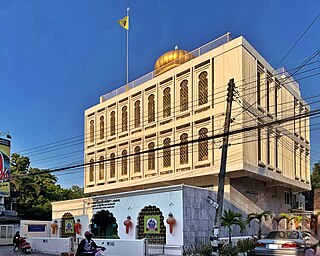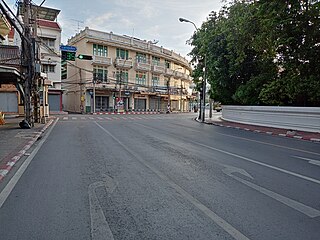
Phra Nakhon is one of the 50 districts (khet) of Bangkok, Thailand. It is the central district of Bangkok, including Rattanakosin Island. Neighboring districts are, from the north, clockwise: Dusit, Pom Prap Sattru Phai, Samphanthawong, and across the Chao Phraya River, Thon Buri, Bangkok Yai, Bangkok Noi, and Bang Phlat.

Yaowarat Road in Samphanthawong District is the main artery of Bangkok's Chinatown. Modern Chinatown now covers a large area around Yaowarat and Charoen Krung Road. It has been the main centre for trading by the Chinese community since they moved from their old site some 200 years ago to make way for the construction of Wat Phra Kaew, the Grand Palace. Nearby is the Phahurat or Little India. The area is bordered by the Chao Phraya River from the west to the south. Yaowarat Road is well known for its variety of foodstuffs, and at night turns into a large "food street" that draws tourists and locals from all over the city.

Sikhism is a recognised minority religion in Thailand, with about 70,000 adherents. The religion was brought by migrants from India who began to arrive in the late 19th century. There are about twenty Sikh temples or Gurdwaras in the country, including the Gurdwara Sri Guru Singh Sabha in Bangkok.

Wongwian Yai, also spelled "Wong Wian Yai" or "Wongwien Yai", is a large roundabout in Thonburi, on the west bank of the Chao Phraya River in Bangkok, Thailand, where the statue of King Taksin is situated.

Wang Burapha is a historic neighbourhood in Bangkok, regarded as the first commercial and entertainment district in contemporary Thailand. It is surrounded by Charoen Krung, Maha Chai, Phahurat, Tri Phet and Burapha roads, as well as short streets branching off the main road including Phiraphong and Phanu Rangsi roads, near the eastern edge of the old city centre of Rattanakosin Island in Wang Burapha Phirom Subdistrict, Phra Nakhon District. The neighbourhood is named after Buraphaphirom Palace, which used to be located here until the 1950s, when it was demolished to make way for commercial developments. The neighbourhood became a major commercial district and a centre of youth culture during the 1950s–60s.

Ban Mo is the name of a street and its corresponding neighbourhood in Bangkok's Wang Burapha Phirom Subdistrict, Phra Nakhon District. It is located just outside the old inner moat in the historic Rattanakosin Island area. The road runs a short distance of 0.6 kilometres (0.37 mi) from Si Kak Phraya Si Intersection, where it meets Charoen Krung and Fueang Nakhon roads, to meet Chak Phet Road in the Pak Khlong Talat area. It passes the beginning of Phahurat Road at Ban Mo Intersection. It can be considered a road with one-way traffic management.

Nightingale–Olympic or The Nightingale–Olympic Co.,LTD. (Thai: ไนติงเกล-โอลิมปิก; or Nightingale is a department store in Thailand. It is the oldest operating department store in Thailand. The store is located on Tri Phet Road in the Phra Nakhon district in Bangkok's Wang Burapha and Phahurat neighborhoods.

The Old Siam Plaza is a shopping mall in Wang Burapha, a historic neighbourhood of Bangkok, Thailand. It is surrounded by Tri Phet, Burapha, Phahurat and Charoen Krung roads, and is near other neighbourhoods such as Yaowarat, Pak Khlong Talat or Ban Mo. It is a four-story air-conditioned building. The building characterized by a blend of colonial and Sino-Portuguese architecture, which was popular during the reign of King Rama V.

Ti Thong Road is one of the roads in inner Bangkok or Rattanakosin Island. A short road, 525 metres (1,722 ft) long, built during the reign of King Chulalongkorn, connecting Bamrung Mueang and Charoen Krung roads. The two were the first official roads in Thailand built during the reign of King Mongkut.

Saphan Han is a small bridge over the Khlong Rop Krung, also known as Khlong Ong Ang in the areas of Bangkok's Chakkrawat sub-district, Samphanthawong district and Wang Burapha Phirom sub-district, Phra Nakhon district. It is also the name of the surrounding area.

Chaloem Wat Chat Bridge is a bridge and four-way intersection in the area of Bang Lamphu, Bowon Niwet and Ban Phan Thom sub-districts, Phra Nakhon district, Bangkok. It's not far from Khao San and Rambuttri roads.

Mo Mi is a large intersection located in the centre of Bangkok's Chinatown quarter lies on the tripoint between Pom Prap of Pom Prap Sattru Phai district and Talat Noi with Samphanthawong of Samphanthawong district.

Chak Phet Road is a road in Wang Burapha Phirom Subdistrict, Phra Nakhon District, Bangkok, with a total length of 1,120 m.

Tri Phet Road is a road in inner Bangkok, it is located in Wang Burapha Phirom Subdistrict, Phra Nakhon District, regarded as one of the memorials to the children of King Chulalongkorn who died as a child as same as Sirirat Hospital, or Uruphong Intersection etc.

Sam Yot station is a Bangkok MRT rapid transit station on the Blue Line. It is regarded as one of four most beautiful MRT stations; the other three are Itsaraphap station, Sanam Chai station, and Wat Mangkon station.

Bang Phrom is a khwaeng (subdistrict) of Taling Chan district, Bangkok's Thonburi side.

The Bangkok tram system (รถรางกรุงเทพ) was a transport system in Bangkok, Thailand. Its first-generation tram network first operated as a horse tram system, and was eventually converted to electric trams in the late nineteenth century.

Banthat Thong Road is a street in Bangkok. It runs 2.2 kilometres (1.4 mi) from its junction with Rama IV Road at Saphan Lueang Intersection, through Pathum Wan and Ratchathewi districts, north to Phet Phra Ram Intersection, where it meets Phetchaburi Road. It crosses Rama I Road at Charoen Phon Intersection, near the National Stadium, and the area is home to a large number of sporting goods shops. The southern section of the road runs parallel to the canal Khlong Suan Luang, which also gives its name to the neighbourhood. The area's land is owned by Chulalongkorn University, whose Office of Property Management (PMCU) redeveloped most of the neighbourhood in the 2010s. The area is host to a variety of street food vendors and restaurants, and is a popular tourist attraction. In 2024, Time Out ranked Ban Tad Thong as the world's 14th coolest street.























